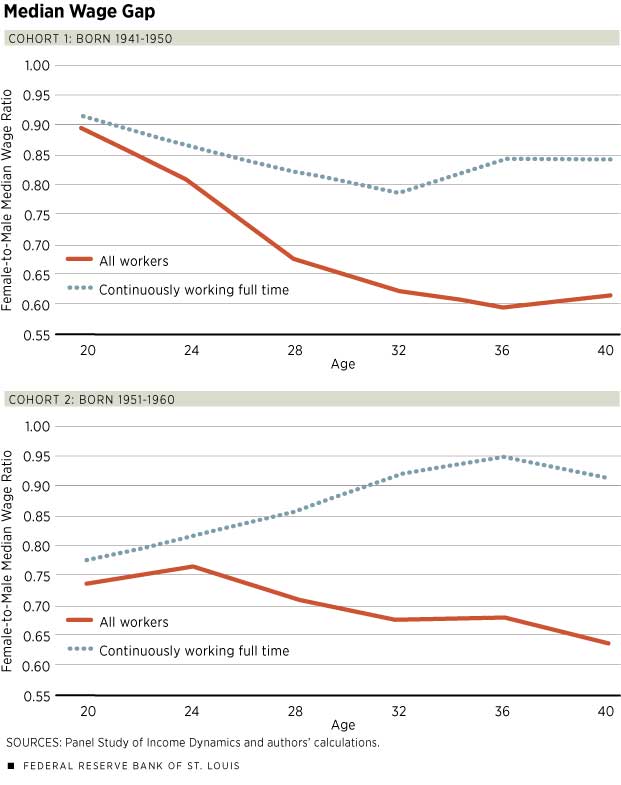Breaking Down the Gender Wage Gap by Age and by Hours Worked
The gender pay gap has declined substantially since the 1960s, a period of many decades when women’s participation in the labor market has risen and their working hours have increased. An especially significant decline in the pay gap occurred in the 1970s and the 1980s. The convergence slowed down in the 1990s, and some gap still remains.1
In this article, we examine the evolution of the wage gap by cohorts. We also look at the evolution over the life cycle to gain further insight into the patterns and possible causes of the gender wage gap. Using data from the Panel Study of Income Dynamics (PSID), we followed the evolution over the life cycle for three cohorts: those born in 1941-1950, those born in 1951-1960 and those born in 1961-1970.
The figure presents the evolution of the gender pay gap over the life cycle for the first two cohorts of white individuals. (An analysis for all races is beyond the scope of this article; there are other issues regarding labor market pay gaps for nonwhites.) The red line shows the median wage of females divided by the median wage of males by age. Where the line is sloping upward, the gender wage gap is declining because the median female wage is larger relative to the median male wage; the opposite is true if the line is sloping downward.
As can be seen from the two charts, the gap increases with age, at least after the age of 24, which is the age by which the majority of individuals have completed their education. Thus, the gender gap when workers are 24 is substantially smaller than the gap when workers are in their mid-30s. This fact is well-known,2 and one of the main reasons for this pattern is that men and women make different choices over the life cycle. As they get older, women are more likely than men to work fewer hours outside the home and have breaks in their labor force participation (yielding less accumulated experience and possibly fewer labor market skills) and are less likely to hold highly compensated jobs with promotion prospects.3
Life Cycle Wage Gap
To further explore the role of labor market experience, we plotted the evolution of the gender pay gap for employees who work full time continuously during their careers. The blue dotted line in the charts shows the gender pay gap within this subset. For each age, we divided the median wage of females who worked full time continuously up to that age by the same for males.4 From the figure, it is clear that the gender wage gap is smaller for those who worked full time continuously than for all workers in general. This is true for all cohorts.
For those in the second cohort (born 1951-1960), the pay gap for those working full time continuously is not only smaller but decreases with age for the most part. This latter fact is in contrast to what is seen in the full sample.
We considered several possible explanations for this pattern. First, the composition of the sample changes. For example, if skilled women (skill can be formal education and training but also innate ability, which is unobserved by the researchers) are more likely to work full time continuously, then the wage gap at a later age reflects the fact that we are comparing the wages of less-skilled women to those of men early on, while we are comparing more-skilled women to men at older ages. (The group of men working full time continuously can be more stable because both more-skilled and less-skilled men are likely to work full time.) Second, while men still work more hours than women, the gap in hours declines in this group; so, the increase in experience (and, therefore, labor market skills) of women who work full time continuously is larger than that of men. Third, the wage gap reflects discrimination, and discrimination of women who continuously work full time declines over time.
Regarding the first explanation, we calculated the share of college-and-above-educated males and females among those who work full time. If anything, after age 25, the education of males continuously working full time is increasing relative to that of females. However, it is still possible that education is simply one dimension of skill and that women in this group are in fact increasingly skilled but their skills are unobserved by the researcher.
Regarding the second explanation, the gap of hours worked between males and females who work continuously full time does not decline substantially. Therefore, we ruled this out, too.
Last, we turn to the third explanation: Labor market experience and discrimination are related.5 Specifically, firms often have costs of hiring and training workers. When they hire people for jobs with good promotion prospects and jobs that require training and long hours, they are likely to seek individuals who are less likely to leave the labor force or to reduce their hours substantially.6 While some women are more inclined to participate in the labor market and work full time, women in general are still more likely to reduce hours or leave the labor force, especially during childbearing years, relative to what men are likely to do. This can lead to lower wages for equally qualified women. Furthermore, since many factors affecting labor supply are not known to employers at the time of hiring, even women who are likely to work long hours and are attached to the labor market as much as men are may earn lower wages because, on average, women with the same qualifications as men are less attached to the labor force than men are.
This type of discrimination is often called statistical discrimination because group affiliation and group averages adversely affect individuals in the group. Over time, employers can typically observe work experience, whether individuals were working and whether they were working full time or part time. Therefore, employers can increasingly identify workers who are less attached to the labor market and, as a result, discrimination of the type described above goes down with age. Since this type of discrimination is more likely to be directed at women, the wages of women who work full time continuously may grow relative to the wages of men due to a decline in discrimination.
Economists George-Levi Gayle and Limor Golan found evidence for this type of discrimination even after accounting for differences in actual hours worked and for unobserved changes in the composition of ability of men and women who work continuously full time (as noted in the possible first two explanations for the data above). Therefore, this type of discrimination accounts for the changes in the gender gap.
Cohort Differences
The gender wage gap increases after the age of 24 for the overall cohort (red lines). The wage gap for young workers in the first cohort is smaller, but it increases more rapidly than the gap in the second cohort. Although the overall gender pay gap was larger in the first cohort, labor force participation of women was substantially lower then. Therefore, for any age group there are differences in the composition of women who work. One possible reason for the faster increase in the gender pay gap for the earlier cohort is that there was a negative selection of women into the labor market in earlier cohorts.7 Married women were less likely to work then, and those who worked were women with lower skills. While skills can be partly unobserved, taking a look at the education composition of men and women who worked in the first cohort suggests that overall (after age 24) the fraction of working men with at least a college degree was higher than that of women, whereas the education gap was much smaller in the second cohort. Thus, some of the pay gap in the first cohort could be due to the gap in education and skills between the two sexes.
We investigated the changes in the education composition of men and women who work full time continuously in each cohort. For the group working full time continuously in the first cohort, females were more educated than males up to age 28; however, the wage gap is declining when males are more educated than females. In the second cohort, the education gap among those working full time continuously declines (with females being more educated than males in all age groups). Thus, education composition does not explain the evolution of the gender pay gap differences in that group.
Conclusion
By comparing the differences in the evolution of the gender pay gap not only by age but by full-time/part-time status, we demonstrated the importance of statistical discrimination and its relationship to labor force participation of women. As one would expect, this type of discrimination plays a smaller role for the third cohort (born 1961-1970) because women in this cohort are more attached to the labor force than women in the past.
At the time this was written, Limor Golan was an economist at the Federal Reserve Bank of St. Louis and Andrés Hincapié was a technical research associate at the Bank.
Endnotes
- See Blau and Kahn. [back to text]
- See Erosa et al., as well as Gayle and Golan. [back to text]
- See Blau and Kahn for a survey. [back to text]
- We defined continuously working full time as those who worked at least 49 weeks of each year and at least 20 hours weekly. The patterns described in this article hold for a higher number of hours a week, but since we break the sample by gender and cohort, we use 20 hours so that the sample is not too thin. [back to text]
- This explanation was proposed by Barron et al. and was extended by Gayle and Golan. [back to text]
- In many cases, some full-time jobs have to be filled if a worker decides to reduce hours and work part time. [back to text]
- See Mulligan and Rubinstein. [back to text]
References
Barron, John M.; Black, Dan A.; and Loewenstein, Mark A. “Gender Differences in Training, Capital and Wages.” Journal of Human Resources, Spring 1993, Vol. 28, No. 2, pp. 343-64.
Blau, Francine D.; and Kahn, Laurence M. “Gender Differences in Pay.” Journal of Economic Perspectives, Fall 2000, Vol. 14, No. 4, pp. 75-99.
Erosa, Andres; Fuster, Luisa; and Restuccia, Diego. “A Quantitative Theory of the Gender Gap in Wages.” European Economic Review, June 2016, Vol. 85, pp. 165-87.
Gayle, George-Levi; and Golan, Limor. “Estimating a Dynamic Adverse-Selection Model: Labor-Force Experience and the Changing Gender Earnings Gap 1968–1997.” The Review of Economic Studies, January 2012, Vol. 79, No. 1, pp. 227-67.
Mulligan, Casey B.; and Rubinstein, Yona. “Selection, Investment and Women’s Relative Wages over Time.” Quarterly Journal of Economics, 2008, Vol. 123, No. 3, pp. 1,061-110.
Views expressed in Regional Economist are not necessarily those of the St. Louis Fed or Federal Reserve System.
For the latest insights from our economists and other St. Louis Fed experts, visit On the Economy and subscribe.
Email Us



